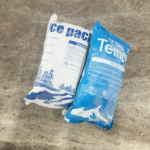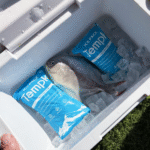Dry Ice Pack Guide 2025: What It Is, How to Use It
A dry ice pack keeps products at ultra‑cold temperatures by using solid CO₂ that vents as it cools. If you need reliable sub‑70 °C shipping today, this dry ice pack guide shows safe packing steps, sizing math, and 2025 compliance so you can ship frozen goods with confidence. It also clarifies naming confusion and offers practical tips tested across real shipments.
-
What a dry ice pack means in practice, and how to avoid naming confusion (long‑tail: dry ice pack vs gel pack)
-
How a dry ice pack works and when to choose it over PCM or gel (long‑tail: ultra‑cold shipping pack)
-
How to size a dry ice pack using a simple formula (long‑tail: how long does a dry ice pack last)
-
Which 2025 labels, marks, and limits apply—and how to pass airline checks
-
Field‑tested packing patterns to extend hold time without over‑engineering
What is a dry ice pack and why does naming matter?
In industry practice, a dry ice pack is a CO₂‑based refrigerant assembly for ultra‑cold shipping. The term can also refer to polymer sheets that hydrate and freeze, but those are not CO₂. To avoid errors, specify whether you need CO₂ dry ice pack or a polymer ice sheet, especially in regulated lanes.
When you order a dry ice pack, ask for UN1845 CO₂ if your product requires below −70 °C. Some vendors market hydratable sheets as a dry ice pack because the surface stays dry. Those sheets are reusable and safer to handle, yet they cannot match the extreme cold of a CO₂ solution. Use the polymer option for 2–8 °C or −20 °C ranges; choose a dry ice pack when deep‑freeze or ultra‑cold control is mandatory.
Encapsulated inserts and smoother temperature profiles
Encapsulated inserts that hold pellets in a tray reduce product cold shock and keep a steadier micro‑climate. Blocks last longer because of lower surface‑area‑to‑mass; pellets pull down fast and are easier to dose. For lanes with frequent door‑opens, a lidded insert above the payload helps keep the dry ice pack from over‑cooling sensitive vials.
| Cold source | Typical range | Notes | What it means for you |
|---|---|---|---|
| Dry ice pack (CO₂) | ≤ −70 °C to −78.5 °C | Vented; no liquid | Use for ultra‑cold biologics and long frozen lanes |
| PCM pack (−20 °C / +5 °C / +22 °C) | Narrow set point | Reusable | Choose for vaccines/samples with tight bands |
| Gel pack (water‑based) | 0 – −10 °C | Condensation possible | Budget option for short chilled food deliveries |
Practical tips & quick wins
-
Door‑open events: Open slowly in a ventilated area; close promptly.
-
Carton fit: Fill voids; air gaps accelerate dry ice pack burn‑off.
-
Block vs pellet: Use more blocks in hot seasons; pellets to pre‑cool before handoff.
Real‑world example: A lab shipping enzyme kits moved from loose pellets in EPS to a lidded insert with more blocks. Hold time rose from 48 h to 72 h on a hot‑season profile, and temperature excursions went to zero across three pilots.
How long does a dry ice pack last, and how much do you need?
Plan by time and expected sublimation, then add a safety buffer. In a mid‑size insulated shipper, the refrigerant often loses several kilograms per day. Warmer profiles, thin foam, and frequent openings increase the rate; vacuum‑insulated panels slow it. FAA testing shows pellets sublimate faster than large blocks, reinforcing the “faster pull‑down vs longer hold” trade‑off.
How do you pack a shipment with a dry ice pack safely in 2025?
Vent, label, and separate payload from the cold source. Use a rigid insulated shipper that permits gas release; never make it air‑tight. Mark “Dry Ice” or “Carbon Dioxide, solid”, include UN1845 and the net weight on the airway bill and box. A Shipper’s Declaration is not required when cooling non‑dangerous goods; operator variations may apply.
USPS note (air): ≤ 5 lb dry ice per mailpiece; international mail is prohibited. Ensure packaging vents CO₂.
-
Pre‑condition the shipper and stage the payload at its qualified temperature.
-
Place a bottom layer of blocks or pellets in a vented sleeve or tray.
-
Add a buffer so product does not sit directly on the cold source unless validated.
-
Load the payload; top off with the remaining mass from your calculation.
-
Close without sealing air‑tight; apply marks and labels; brief the receiver on opening SOP.
Safety first: ventilation, PPE, and facility controls
Protect people first. Carbon dioxide can quickly displace oxygen; target below 5,000 ppm time‑weighted average and below 30,000 ppm short‑term. Use insulated gloves and eye protection, ventilate vehicles and rooms, and avoid storing any dry ice pack in sealed containers.
One pound of dry ice becomes ~250 L of gas, so even a small charge can over‑pressurize a closed cooler. Add a CO₂ monitor in enclosed docks and vans, train teams on safe opening, and keep SOP cards with every shipment.
2025 trends in ultra‑cold shipping
What’s new this year: Smart sensors, validated hybrid shippers, and standardized lane testing. Many teams pair a dry ice pack with PCM “buffers” to flatten spikes and cut total ice mass. Qualification to ISTA 7E profiles speeds audits and reduces excursion risk on hot lanes.
Latest developments at a glance
-
VIP + PCM hybrids: Longer hold with less CO₂; smoother profiles.
-
Acceptance checklists: Faster airline checks when cooling non‑DG goods.
-
CO₂ monitoring: Portable sensors on docks and vans to protect staff.
Market insight: Demand remains strong in healthcare and food e‑commerce. Shippers that right‑size their dry ice pack and validate to lane profiles reduce cost, waste, and claims.
Frequently Asked Questions
Is a dry ice pack the same as a polymer ice sheet?
No. A dry ice pack typically uses solid CO₂ that vents; a polymer sheet is water‑based and reusable. Confirm which one your lane requires.
Do I need a dangerous goods declaration for CO₂ refrigerant?
When it cools non‑dangerous goods, a declaration is usually not required, but UN1845, the proper name, and net weight must appear on the waybill and package.
How much do I need for 48 hours?
Start with 3–4.5 kg per day in a mid‑size VIP/EPS shipper, add 20% buffer, and validate with a logger.
Can I seal the box tightly to trap cold?
No. Packages must vent CO₂ to avoid pressure build‑up and rupture risk. PI 954 requires gas release.
Is it safe for food?
Yes, but avoid direct contact with unpackaged food to prevent freezer burn; always use a barrier bag.
Summary & recommendations
Key takeaways: A dry ice pack is the simplest way to achieve ≤ −70 °C on long lanes. Vent every package and mark UN1845 with net weight. Size by time and expected sublimation plus buffer, and validate against lane profiles to prevent excursions.
Next steps: Map your lane, estimate mass with the formula, run a pilot with data logging, then standardize your SOP. Ready for a lane‑based plan? Get a tailored dry ice pack configuration and validation checklist from our team.
About Tempk
Tempk designs and qualifies cold‑chain systems for pharma, biotech, and food. We build CO₂ dry ice pack kits and VIP‑PCM hybrids with audit‑ready documentation. Our customers report fewer excursions and lower replenishment rates after moving to lane‑validated designs. Talk to an expert for a recommendation aligned to your routes and label claims.
























